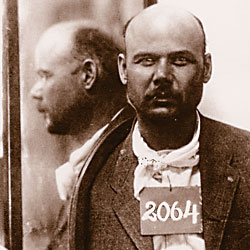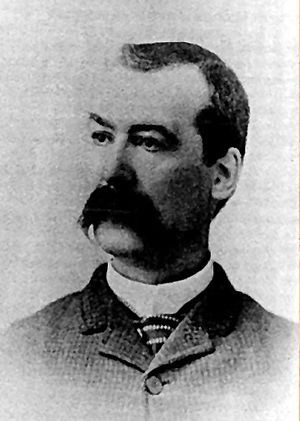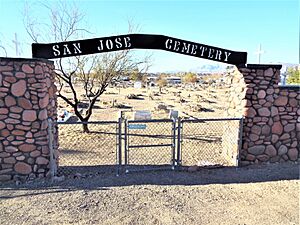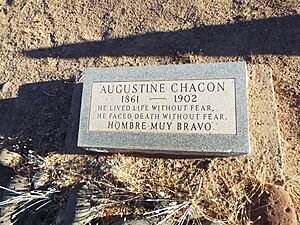Augustine Chacon facts for kids
Quick facts for kids
Augustine Chacon
|
|
|---|---|
 |
|
| Born | 1861 Sonora, Mexico
|
| Died | November 21, 1902 (aged 40–41) Solomonville, Arizona Territory, United States
|
| Nationality | Mexican |
| Other names | El Peludo |
| Known for | Armed robbery, cattle rustling, horse theft |
Augustine Chacon (born 1861, died 1902) was a famous Mexican outlaw. People called him El Peludo, which means "The Hairy One" in English. He was active in the Arizona Territory and near the U.S.–Mexico border in the late 1800s and early 1900s.
Even though he was an outlaw, many people liked him. They saw him as a Robin Hood-like figure, someone who stole but was also kind to others. A historian named Marshall Trimble said Chacon was "one of the last of the hard-riding desperados" in Arizona. He was known to be very dangerous. Chacon escaped from jail twice before he was finally caught by Burton C. Mossman and executed in 1902.
Contents
How Chacon Was Captured

Around 1900, Arizona was still a wild place, especially near the Mexican border. There was a lot of robbery and cattle theft. Because of this, the governor of Arizona decided to bring back the Arizona Rangers in 1901. Burton C. Mossman became the first captain of this group.
Mossman's last big achievement before leaving his job was capturing Augustine Chacon. He came up with a clever plan. Mossman decided to pretend he was an outlaw himself. He also got help from a train robber named Burt Alvord. Alvord was a friend of Chacon and could help Mossman trick him.
Mossman knew Alvord was hiding in Sonora, Mexico. He traveled for days by wagon and horse to find him. On April 22, 1902, Mossman found Alvord's hideout. Mossman approached Alvord unarmed. Alvord was surprised to see a police officer, but he listened to Mossman's plan.
They agreed to work together. Alvord would help Mossman catch Chacon. In return, Alvord hoped for a lighter sentence for his own crimes and a reward for Chacon's capture. Another outlaw, Billy Stiles, acted as their messenger.
It took over three months for Alvord to find Chacon. They even went to the Yaqui River to sell stolen horses. Finally, Alvord convinced Chacon to come back towards the Arizona border. Alvord sent Stiles to tell Mossman where to meet them.
Mossman and Stiles missed the first meeting spot. But the next night, they found Chacon and Alvord at Alvord's wife's house. They all agreed to cross into Arizona the next day. They planned to steal horses from Greene's Ranch.
However, it was too dark to steal horses that night. They went back to their camp, which was close to the border. Early in the morning on September 4, 1902, Alvord quietly told Mossman that he had done his part. He warned Mossman to be careful because Chacon was dangerous.
Chacon's Capture Details
When Chacon woke up, he noticed Alvord was gone. This made him suspicious. Stiles suggested they steal horses in daylight, but Chacon wanted to go back to Sonora. Mossman knew this was his chance.
Chacon and Stiles were sitting on the ground. Mossman stood up and asked Chacon for a cigarette. As he dropped the twig he used to light it, Mossman quickly pulled out his gun. He aimed it at Chacon and said, "Hands up, Chacon."
Chacon asked if it was a joke. Mossman replied, "No. Throw your hands up or you're a dead man." Chacon then said, "I don't see as it makes any difference after he is dead whether man's hands are up or down. You're going to kill me anyway, why don't you shoot?"
Mossman had Stiles take Chacon's weapons. Then, they put Chacon on a horse to travel to the railroad. They took a train to Benson, Arizona. Chacon tried to escape several times by jumping off his horse. He tried to get away in places where Mossman could not easily follow him.
Chacon's Final Days
Mossman's plan worked perfectly. In Benson, Mossman handed Chacon over to the sheriff. Chacon was then taken back to Solomonville. He had already been sentenced to be executed. So, his court appearance was just to set a new date for his execution.
The first date was November 14, 1902. Some local citizens tried to get his sentence changed to life in prison. But their effort failed. The court decided Chacon would be executed on November 21.
While waiting, Chacon was kept in a strong steel cage with many guards. The gallows, the structure used for executions, had been built for him in 1897. But he had escaped before it could be used then. A tall adobe wall was built around the gallows. This was so only people with special invitations could watch.
On the day of his execution, Chacon had a good breakfast. He was allowed to see two friends and a Catholic priest. After lunch, he was given a shave and a new black suit. Chacon was brought to the gallows at 2:00 PM. About fifty people were waiting to see him.
Chacon, who had avoided the law for over ten years, asked for a cigarette and coffee. Then, he gave a thirty-minute speech to the crowd. He spoke in Spanish, with an English interpreter. Chacon said he was innocent of killing his friend, Pablo Salcido, or anyone else. But he admitted he was guilty of stealing and "many other things."
After another cigarette and coffee, Chacon asked to live until 3:00 PM. His request was denied. As he walked up the steps of the gallows, Chacon shook hands with his friends. When the rope was ready, Chacon's last words were "Adios, todos amigos" (Goodbye, all friends). A newspaper reported that Chacon was a very brave man. His execution was a dramatic event that people would never forget.
Augustine Chacon had at least one child, a son. His family members still live today. In 1980, some of his family placed a marble gravestone at the San Jose Cemetery. This is where his remains are. Chacon's gravestone reads:
- AUGUSTINE CHACON
- 1861–1902
- HE LIVED LIFE WITHOUT FEAR,
- HE FACED DEATH WITHOUT FEAR.
- HOMBRE MUY BRAVO
Chacon in Popular Culture
Augustine Chacon's story has been told in television shows.
- In 1955, the actor Rodolfo Hoyos, Jr. played Chacon in an episode of the TV series Stories of the Century.
- In 1963, Michael Pate played Chacon in the episode "The Measure of a Man" of the TV series Death Valley Days. In this story, Burt Mossman (Rory Calhoun) convinces Burt Alvord (Bing Russell) to help catch Chacon. Chacon is then executed for a past crime he had escaped from.




